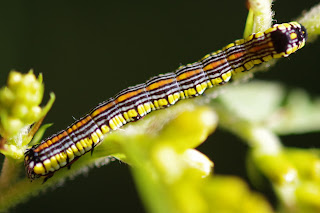I had a specific area that I wanted to take pictures of, or rather, specific plants. At the edge of the part of our property that we call the field, just before entering the woods, there is a spot where there is some goldenrod and quite a lot of "stinky tree" saplings. I knew from yesterday's walk what I would find there, and I was not disappointed. So today I have a Backyard Bug of the Day that I can show to you in three life stages: larva, pupa, and imago (adult). And the reason I could find all three stages there is because of those two specific plants; the goldenrod feeds the adult, and the stinky tree, properly known as ailanthus, is the host for the larvae (caterpillars), and that is also where they pupate. Have you guessed what today's Backyard Bug of the Day is?
Backyard Bug of the Day as a larva:
Ailanthus webworm
Ailanthus webworm pupa
Ailanthus webworm moth
The caterpillars have a communal web that is a mass of tangled silk threads. There will be caterpillars in various instars in there, and they pupate right in there, too. So here you can see both caterpillars and pupae. Also, frass.
Adult on an ailanthus leaf
Many of the young ailanthus plants have webs on them. This one has a small web with a few earlier instar caterpillars.
The nearby goldenrod flowers are obviously a great food source for the moths when they emerge. Obviously the bees like the goldenrod, too.
Three species of bees and a moth
Lots of bugs on the goldenrod today:
Assassin bug nymph. Any flowers where there are a lot of insects feeding on the flowers is a good place to hang out it you are a predatory insect.
Hemiptera, but I don't know if it is a predator, or if it is feeding on the plant.
I don't know what this plant is, but it is also a bee magnet now that it is in bloom:
Other Bugs:
Lady beetle romance
I found another monarch caterpillar today, in another part of the backyard.
And two of the originals (?) are still around:
And there were a couple more large milkweed bugs, too:
Brown hooded owlet moth caterpillar:
Such a shame that so vibrant a caterpillar turns into a dull, brown moth. There's probably some sort of life lesson in that, but I don't know what it is.
Tortoise beetle
Two kinds of katydids:
I saw a lot of butterflies today, and managed to get pictures of three, although none were very cooperative:
Cabbage white
I think this is a pearl crescent.
I don't know what this one is. I didn't precisely break my rule not to chase butterflies, but I did make a big effort to get a picture of it in this patch of wild lettuce. It was uncooperative:
Finally!
I see a lot of spiders in the woods these days, mostly spined micrathenas that have built their webs across the paths, but I have not been seeing them in the backyard much. So, no Arachnid Appreciation.





























































